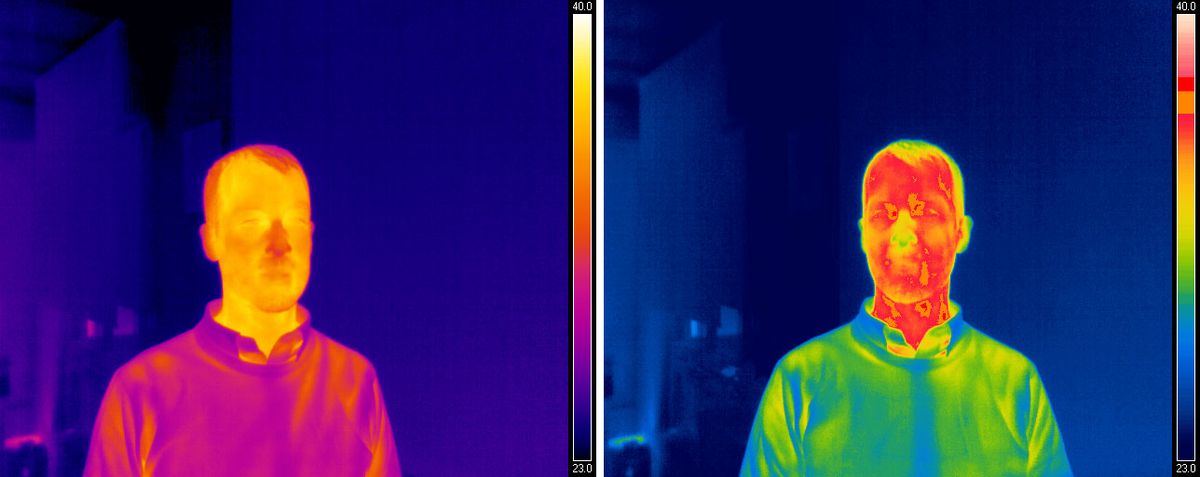THE INSTITUTE Thermal imaging cameras, which use thermography, are a fast, contactless, and reliable method to detect a fever, a common symptom of COVID-19. Two IEEE members, one in Spain and the other in Switzerland, are working on separate projects that improve the technology used in these cameras so they can be used in places such as airports, hospitals, factories, office buildings, restaurants, and stores to provide fast individual screenings to help stop the spread of the virus.
IEEE Member Alejandro Kurtz de Grino a design and research engineer at software company BCB Informática y Control SL, in Madrid, is developing software that help the cameras meet technical standards required by the healthcare industry.
The thermal imaging camera that IEEE Fellow Touradj Ebrahimi is building also checks for elevated blood temperature but it can trace the person’s contacts. He also developed a cryptographic tool to ensure the privacy of the person whose temperature is being checked. Ebrahimi is a professor of multimedia signal processing at Ecole Polytechnique Fédérale de Lausanne, in Switzerland.
NEW SOFTWARE
De Grino says thermographic cameras used in the healthcare field must meet specific standards. For example, the screening technology must have a high thermal resolution and a measurement accuracy of +/- 0.5 ºC. Several manufacturers of these cameras are not following those requirements, he says, so his company is developing software for them that does.
“It wasn’t easy to develop a solution that met the requirements of the technical standard for fever screening using thermal cameras,” de Grino says.
The software will be tested in cameras made by FLIR Systems, a leading manufacturer of thermographic cameras. FLIR has several models that, when paired with his company’s bcbTempScan software, meet the international standards. The cameras have infrared temperature sensors and motorized focus, which are controlled by the software’s system operator. The temperature sensors detect electromagnetic waves from the person and the motorized focus allows the camera’s operator to zoom in and out.
The software uses GigE Vision and Genlcam, de Grino says. GigE Vision is an interface standard that can transmit high-speed video and related control data over an Ethernet connection. Genlcam is a common programming interface used for machine vision in cameras.
BcbTempScan is connected to the camera through a computer. When checking a person, the camera’s operator will see a detailed temperature pattern, called a thermogram and an alarm will sound if EBT is detected, de Grino says. The operator will then recommend to the person he or she be tested for COVID-19.
PROTECTING PRIVACY
The Pro-Cam infrared camera that Ebrahimi and his students built combines infrared, thermal, and visible light sensors while securing the visible light images.
“We designed and built a new type of connected camera with multiple sensors that can track people, also known as proximity or contact tracing, while protecting their privacy,” he says.
The cameras are made from off-the-shelf components and open software so they are less expensive than existing thermal cameras and can be easily built and installed. The team also created a custom enclosure to protect its components.
Using real-time streaming, Ebrahimi says the camera sends the images to a server and protects the anonymity of the individual in the scene by hiding the visible light images inside thermal images using a cryptographic tool called transmorphing.
A dedicated server records all the captured footage in a secure and anonymized way with the possibility for further analysis, visualization and eventual de-anonymization, he adds.
Ebrahimi says the camera is more accurate than current contact tracing methods that use smartphone positions, or Bluetooth discovery to determine the relative distance between devices. The Pro-Cam also doesn’t require individuals to carry a smartphone or install a contact-tracing app.
Also, these technologies pose various ethical challenges, including invasion of privacy. Ebrahimi says it will be possible to recover the person’s identity using cryptographic keys if consent is given or when the proper authorities make a request for the information.
The project wasn’t without its challenges, he says. Because low-cost infrared and thermal sensors have lower resolution and precision, the team had to combine three such sensors along with advanced image processing algorithms.

“Even though everyone on the project worked remotely, they came up with the camera’s design from scratch and had it ready to build in 72 hours!” Ebrahimi says.
Three students will continue building other cameras as part of their senior project and will run trials on them from selected locations. Ebrahimi says further enhancements will include the ability to perform AI-based advanced video analytics, trace people between cameras, and merge with other proximity-tracing approaches such as those based on smart cameras.
This article appears in the September 2020 print issue as “Thermal Cameras’ New Role: Controlling COVID-19 Community Spread.”
Attention IEEE members: are you part of a team responding to the COVID-19 crisis? We want to hear from you! Wherever you are and whatever you are doing, if you are helping deal with the outbreak in some way, let us know. Send us accounts of anywhere from 200 to 800 words, or simply give us a rough idea of what you are doing and your contact information. Write to: k.pretz@ieee.org
Kathy Pretz is editor in chief for The Institute, which covers all aspects of IEEE, its members, and the technology they're involved in. She has a bachelor's degree in applied communication from Rider University, in Lawrenceville, N.J., and holds a master's degree in corporate and public communication from Monmouth University, in West Long Branch, N.J.



